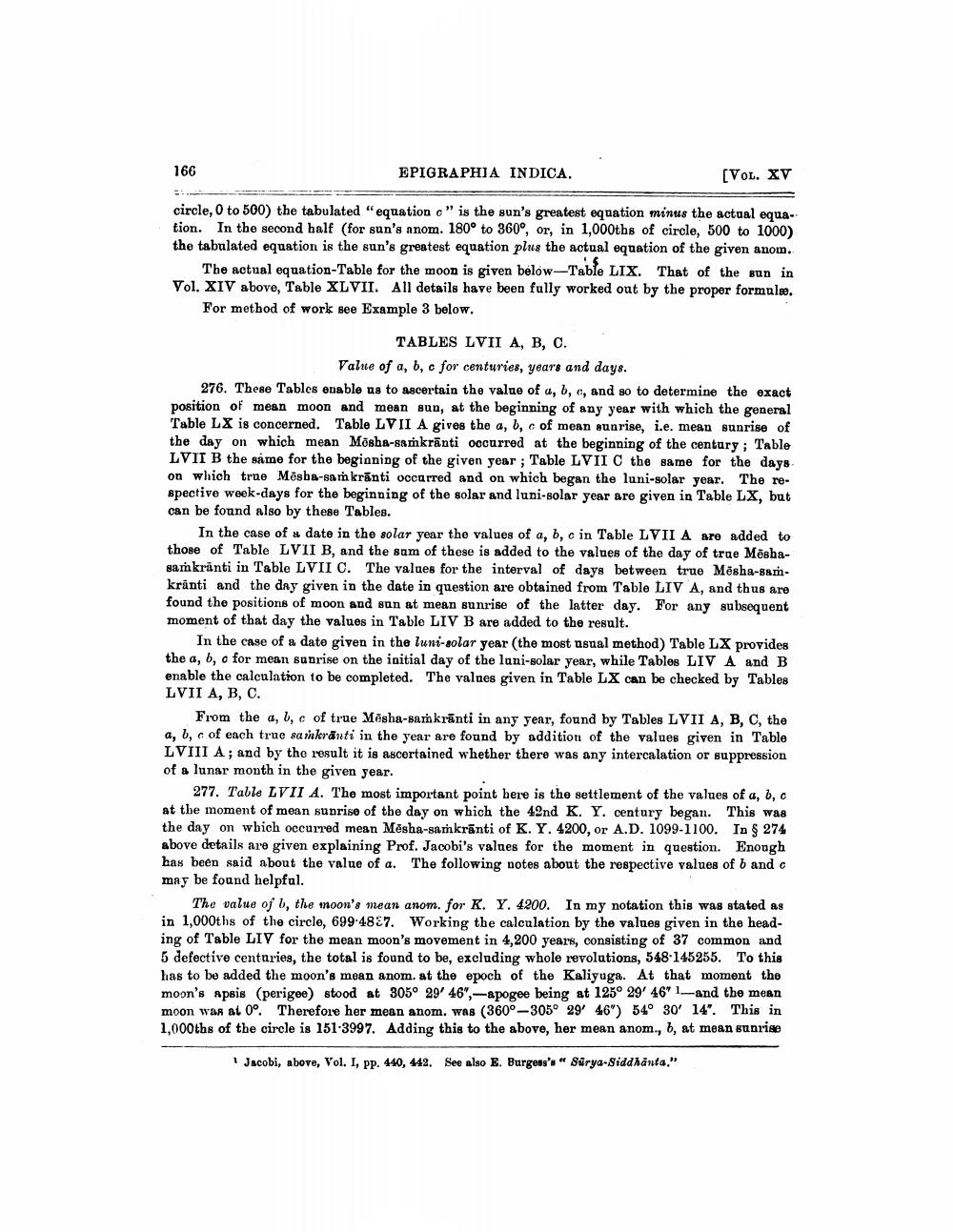________________
166
EPIGRAPHIA INDICA.
[VOL. XV
circle, 0 to 500) the tabulated "equation c" is the sun's greatest equation minus the actual equation. In the second half (for sun's anom. 180° to 360°, or, in 1,000ths of circle, 500 to 1000) the tabulated equation is the sun's greatest equation plus the actual equation of the given anom.
The actual equation-Table for the moon is given below-Table LIX. That of the sun in Vol. XIV above, Table XLVII. All details have been fully worked out by the proper formulae. For method of work see Example 3 below.
TABLES LVII A, B, C.
Value of a, b, c for centuries, years and days.
276. These Tables enable us to ascertain the value of a, b, c, and so to determine the exact position of mean moon and mean sun, at the beginning of any year with which the general Table LX is concerned. Table LVII A gives the a, b, c of mean sunrise, i.e. mean sunrise of the day on which mean Mosha-samkranti occurred at the beginning of the century; Table LVII B the same for the beginning of the given year; Table LVII C the same for the days on which true Mesha-sam kranti occurred and on which began the luni-solar year. The respective week-days for the beginning of the solar and luni-solar year are given in Table LX, but can be found also by these Tables.
In the case of a date in the solar year the values of a, b, c in Table LVII A are added to those of Table LVII B, and the sum of these is added to the values of the day of true Mēshasamkrānti in Table LVII C. The values for the interval of days between true Mesha-samkranti and the day given in the date in question are obtained from Table LIV A, and thus are found the positions of moon and sun at mean sunrise of the latter day. For any subsequent moment of that day the values in Table LIV B are added to the result.
In the case of a date given in the luni-solar year (the most usual method) Table LX provides the a, b, c for mean sunrise on the initial day of the luni-solar year, while Tables LIV A and B enable the calculation to be completed. The values given in Table LX can be checked by Tables LVII A, B, C.
From the a, b, c of true Mesha-samkranti in any year, found by Tables LVII A, B, C, the a, b, c of each truc samkranti in the year are found by addition of the values given in Table LVIII A; and by the result it is ascertained whether there was any intercalation or suppression of a lunar month in the given year.
277. Table LVII A. The most important point here is the settlement of the values of a, b, c at the moment of mean sunrise of the day on which the 42nd K. Y. century began. This was the day on which occurred mean Mesha-samkranti of K. Y. 4200, or A.D. 1099-1100. In § 274 above details are given explaining Prof. Jacobi's values for the moment in question. Enough has been said about the value of a. The following notes about the respective values of b and c may be found helpful.
The value of 1, the moon's mean anom. for K. Y. 4200. In my notation this was stated as in 1,000ths of the circle, 699-487. Working the calculation by the values given in the heading of Table LIV for the mean moon's movement in 4,200 years, consisting of 37 common and 5 defective centuries, the total is found to be, excluding whole revolutions, 548-145255. To this has to be added the moon's mean anom. at the epoch of the Kaliyuga. At that moment the moon's apsis (perigee) stood at 305° 29′ 46",-apogee being at 125° 29′ 46" 1-and the mean moon was at 0°. Therefore her mean anom. was (360°-305° 29′ 46′′) 54° 30' 14". This in 1,000ths of the circle is 151-3997. Adding this to the above, her mean anom., b, at mean sunrise
1 Jacobi, above, Vol. I, pp. 440, 442. See also E. Burgess's "Sürya-Siddhänta."




